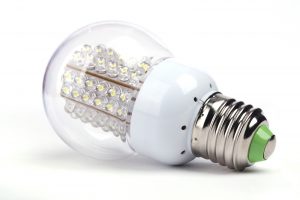Running the Numbers: LED Retrofits Make Financial Sense
By George Crawford
 One way or another, every building in New York City will need to upgrade to LED. Well, every building larger than 25,000 s.f. And the extent of the upgrades depends on whether the building is classified as residential or commercial.
One way or another, every building in New York City will need to upgrade to LED. Well, every building larger than 25,000 s.f. And the extent of the upgrades depends on whether the building is classified as residential or commercial.
Residential buildings are only required to upgrade common areas—such as lobbies, hallways, and stairs—and service areas. Living areas are excluded, so apartment owners can make that call for themselves.
On the other hand, commercial buildings are required to upgrade all interior lighting, including common areas and office lighting. Because hotels and assisted-living facilities are classified as commercial, hotel guest rooms and living areas in nursing homes, hospitals, and assisted-living facilities must also upgrade to LED.
Granted, this upgrade requirement can be a large undertaking for any building, both in terms of expense and execution. However, these LED retrofits also have a substantial upside.
LED Upgrade Analytics
Because LED upgrades significantly reduce electricity consumption, they also generate significant savings. To illustrate, consider these examples:
- Replacing a 60-watt incandescent bulb—common to every household—with a 9-watt LED lamp reduces electrical consumption by 85%.
- The LED replacement for a 40-watt incandescent bulb uses only 5 watts, a savings of 88%.
- A four-foot T8 fluorescent tube consumes 32 watts, while the LED equivalent uses only 12 watts, a 63% savings.
Converting these savings into actual dollars should motivate those buildings that have yet to comply with Local Law 88 to start their LED retrofit.
- A single 60-watt incandescent lamp costs $126 a year to operate, while the LED replacement will cost $18 per year. Calculations are based on a quality LED 9-watt replacement with a five-year warranty. In this example, the five-year savings would total $540 for a single bulb. These savings do not include the costs of replacing the incandescent bulb multiple times during that time due to its short useful life.
- Take the 40-watt incandescent candle, common to chandeliers and sconces. Each 40-watt lamp costs $84 a year, compared to $10.56 a year for a 5-watt LED candle. In a lobby chandelier with 10 candle lamps, the potential five-year savings would be $3,672.
These examples show the significant savings potential, which ranges from 63% up to 88%. Upgrading to LED lamps will result in a dramatic drop in electric consumption in every building, while bringing them into LL 88 compliance.
Quality Products
To make this savings equation work, building owners need to purchase high-quality LED products. The above examples reference LED products with five-year warranties. All high-quality LED products are available with warranties of at least five years. In terms of these warranties, it is important to source products only from high-end manufacturers, such as Universal or Philips, which are known to stand behind their warranties.
Certainly, LED products of lesser quality are available at lower prices—but with good reason. Lower quality levels result in shorter useful lives. LED products with short useful lives will yield lower levels of savings. The additional cost of a quality LED product, backed by a warranty of five years or more, is far more cost-effective than an inferior product with an uncertain life span.
Bottom Line: Don’t let anyone fast-talk you into purchasing anything other than a top-quality LED product.
George Crawford leads Green Partners LLC, which identifies money-saving solutions of owners of commercial and residential properties in New York City. For help with your energy needs, please contact George by email at gcrawford@greenpartnersny.com.

